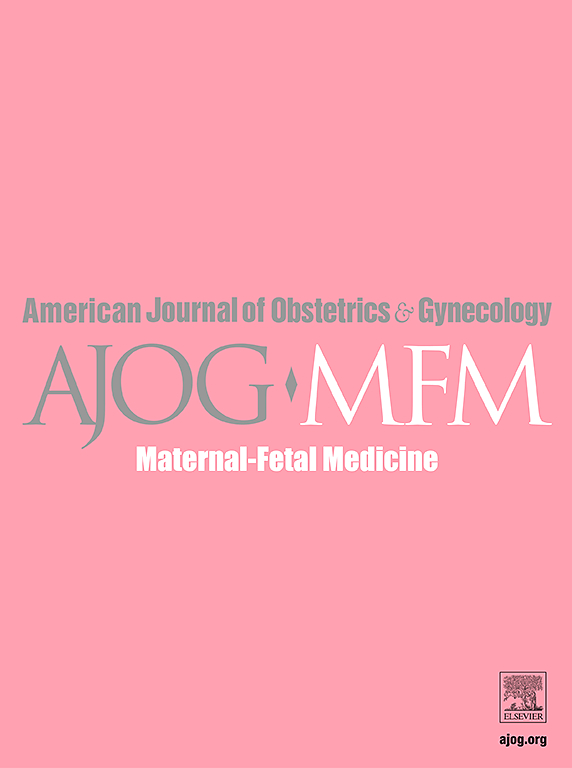Management of cervical cerclage after preterm premature rupture of membranes: an argument for retention
IF 3.8
2区 医学
Q1 OBSTETRICS & GYNECOLOGY
American Journal of Obstetrics & Gynecology Mfm
Pub Date : 2025-03-01
DOI:10.1016/j.ajogmf.2024.101569
引用次数: 0
Abstract
Preterm birth remains the leading cause of infant morbidity and mortality worldwide. Efforts aimed at reducing preterm birth rates have largely focused on mitigating risks in those who have already experienced a preterm delivery. Of note, 1 intervention, the placement of a cervical cerclage, has been shown to reduce the risk of subsequent preterm delivery in appropriate candidates. However, a cerclage does not mitigate the risk of preterm premature rupture of membranes. Preterm premature rupture of membranes is a significant contributor to the incidence of preterm births and can occur with a cerclage in place. Many studies have examined the outcomes associated with immediate vs delayed cerclage removal after preterm premature rupture of membranes with inconsistent results. This expert review summarized the characteristics of the studies examining the timing of cerclage removal after preterm premature rupture of membranes (Table 1) and current international guidelines (Table 2). In the absence of labor, infection, cervical laceration, or vaginal bleeding, it is recommended that cervical cerclage remains in situ after preterm premature rupture of membranes until 32 to 34 weeks of gestation.
胎膜早破后宫颈环扎术的管理:主张保留宫颈:胎膜早破后保留宫颈环扎与去除宫颈环扎的对比。
早产仍然是全世界婴儿发病和死亡的主要原因。为降低早产率所做的努力主要集中在降低已经历过早产的产妇的风险上。有一项干预措施,即放置宫颈环扎术,已被证明可以降低适当人选的后续早产风险。但是,宫颈环扎并不能降低胎膜早破(PPROM)的风险。胎膜早破是导致早产的一个重要因素,而且可能在使用宫颈环扎的情况下发生。许多研究都探讨了胎膜早破后立即去除宫颈环与延迟去除宫颈环的相关结果,但结果并不一致。在本专家综述中,我们总结了有关 PPROM 发生后去除宫颈环时机的研究特点(表 1)以及当前的国际指南(表 2)。在没有分娩、感染、宫颈裂伤或阴道出血的情况下,我们建议在 PPROM 发生后将宫颈环留在原位直至妊娠 32-34 周。
本文章由计算机程序翻译,如有差异,请以英文原文为准。
求助全文
约1分钟内获得全文
求助全文
来源期刊

American Journal of Obstetrics & Gynecology Mfm
Medicine-Medicine (all)
CiteScore
7.40
自引率
3.20%
发文量
254
审稿时长
40 days
期刊介绍:
The American Journal of Obstetrics and Gynecology (AJOG) is a highly esteemed publication with two companion titles. One of these is the American Journal of Obstetrics and Gynecology Maternal-Fetal Medicine (AJOG MFM), which is dedicated to the latest research in the field of maternal-fetal medicine, specifically concerning high-risk pregnancies. The journal encompasses a wide range of topics, including:
Maternal Complications: It addresses significant studies that have the potential to change clinical practice regarding complications faced by pregnant women.
Fetal Complications: The journal covers prenatal diagnosis, ultrasound, and genetic issues related to the fetus, providing insights into the management and care of fetal health.
Prenatal Care: It discusses the best practices in prenatal care to ensure the health and well-being of both the mother and the unborn child.
Intrapartum Care: It provides guidance on the care provided during the childbirth process, which is critical for the safety of both mother and baby.
Postpartum Issues: The journal also tackles issues that arise after childbirth, focusing on the postpartum period and its implications for maternal health. AJOG MFM serves as a reliable forum for peer-reviewed research, with a preference for randomized trials and meta-analyses. The goal is to equip researchers and clinicians with the most current information and evidence-based strategies to effectively manage high-risk pregnancies and to provide the best possible care for mothers and their unborn children.
 求助内容:
求助内容: 应助结果提醒方式:
应助结果提醒方式:


